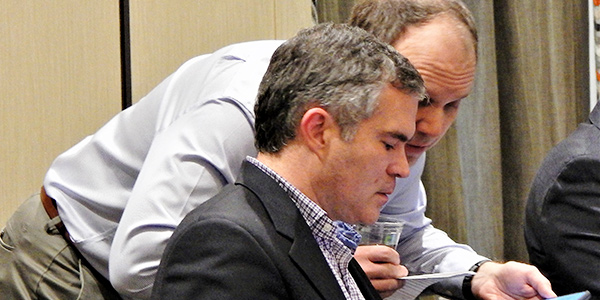By Tom Kleckner
SANTA FE, N.M. — SPP stakeholders last week delayed a decision over the weighting of futures and the use of economic must-run modeling in the RTO’s 2021 transmission planning assessment.
Staff and the Economic Studies Working Group committed to providing additional information to the Markets and Operations Policy Committee during its April meeting in Little Rock, Ark.
The ESWG last month agreed on a 60-40 weighting split between Future 1 — the “business-as-usual” case that reflects current trends — and Future 2, which is driven by assumptions that distributed generation, demand response, energy efficiency and energy storage will have a major effect on load and energy growth rates. The ratio passed both the ESWG and Transmission Working Group with a single abstention each.
Renewable interests favored a more aggressive forecast that incorporates additional energy growth. Others, wary of increasing transmission costs, favored a more conservative approach. Future 1 projects about 32 GW of wind installations by 2031, while Future 2 foresees about 37 GW.
Casey Cathey, SPP’s manager of reliability planning and seams, said that a similar 60-40 split in the 2019 Integrated Transmission Planning assessment would not have changed its final results for identifying transmission needs.
“Some people think there should have been more wind assumptions,” Cathey said. “In the end, after all that debate, it would not have budged our 2019 portfolio.” (See “MOPC Approves $336 ITP Portfolio,” SPP MOPC Briefs: Oct. 15-16, 2019.)
SPP Senior Vice President of Engineering Lanny Nickell suggested identifying reasonable outcomes and assigning them probabilities.
“Once you do that and you’re confident you considered the outcomes, you’re going to make the best quality decision at that time,” he said, noting no one had mentioned the implications of extended tax credits for wind energy.
“It feels like whether you want chocolate or vanilla ice cream. There’s no scientific basis,” SPP Board Chair Larry Altenbaumer said during the Strategic Planning Committee’s meeting Wednesday. “Some prefer one; some prefer the other. That feels lacking to me. It doesn’t seem a very good way to get to where we need to be.”
Must-run Review
Also drawing considerable stakeholder discussion was the ESWG’s plan to assign economic must-run designations to cogeneration, nuclear and hydro units. Exceptions would have to be requested during the generation review and approved by the working group.
However, a list shared with stakeholders included several coal-fired units previously granted exceptions, including Sunflower Electric Power’s 349-MW Holcomb 1. The 37-year-old unit in western Kansas has been often criticized for causing congestion in the area and creating the need for additional transmission investment.
Al Tamimi, Sunflower’s vice president of transmission planning and policy, told RTO Insider that the utility is contractually obligated to a coal delivery contract, executed in 2004 before it became an SPP member, that does not expire until 2034.
Tamimi said no studies completed through the planning-study processes confirm the assertion that congestion will be reduced by removing Holcomb from the list of economic must-run units. Energy exported from Sunflower’s transmission zone far outpaces Holcomb’s production during periods of high wind and also increases congestion, he said.
“As a must-run unit, [Holcomb] … will be dispatched down during high-wind periods … and dispatched up during periods when wind output is lower, which will help alleviate congestion on the byway lines around the unit,” Tamimi said. “Removing coal units like Holcomb from the economic must-run list will most likely drive new economic transmission capital projects to Sunflower’s [transmission] zone. If the new transmission is byway-funded, the Sunflower zone pays almost 70% of its cost and receives negative benefit from it.”
Greg McAuley, Oklahoma Gas & Electric’s director of RTO policy and development, said his concerns about including Holcomb on the economic must-run list centered around the potential effect of a unilateral decision to self-commit a unit out-of-merit on transmission planning.
“We simply want to ensure that we’re all being treated fairly, and that our customers are not being asked to pay for unilateral decisions made by other entities,” McAuley said.
Coincidentally, while the MOPC meeting was taking place, Sunflower announced it would let its air permit for a proposed second Holcomb unit expire in March. Colorado-based Tri-State Generation & Transmission’s decision to pull out of the $2.2 billion, 895-MW project was the final straw for a project first proposed in 2005 during former Kansas Gov. Kathleen Sebelius’ administration.
ESWG Chair Alan Myers, with ITC Holdings, was able to secure approval of leveraging existing processes to model member-submitted loads from the Bakken shale play in the upper Midwest area; to begin developing approaches that address winter-peaking and cold-weather-driven reliability issues for incorporation in SPP’s normal planning processes; and obtain a waiver of the ITP manual’s requirement to use resource planning software in the 2021 assessment.
Members also approved an ESWG revision request (RR395) that creates a hybrid methodology for gas price forecasts by averaging multiple sources.





